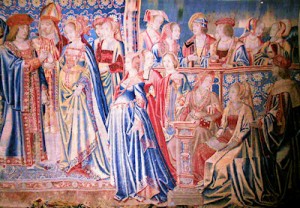
Here is a primary source account of Mary’s arrival at Abbeville and the wedding written by the Venetian ambassador:
“Then followed the Queen, under a white canopy, above and around which were the roses, supported by two porcupines. She was alone beneath it, and Monseigneur [d’Angoulême] on her left hand, but outside. She rode a white palfrey, with rich trappings, and was herself clad in very handsome stiff brocade.
Next came her litter, very beautiful, adorned with lilies; then five of the principal English ladies, very well dressed; then a carriage of brocade, on which were four ladies, followed by a second carriage with as many more ladies. Next came six ladies on horseback; and then a third carriage, of purple and crimson velvet (veluto paonazo cremesin), with four ladies; after which a crowd of ladies, some twenty in number; then 150 archers in three liveries. In this order they went to the Queen’s house, which was near that of the King. It was a sumptuous entry, and these noblemen of England have very large chains, and are otherwise in good array.
Before the entry there was a heavy shower, which drenched them all, especially the ladies. The Queen was dressed in the English fashion. In the evening, “Madame,” the King’s daughter, wife of Monseigneur d’Angoulême, went to visit her, and they gave a ball. This morning the King had preparation made for the mass in his own hall (salla), whither the Queen came, preceded by 73 (sic) English barons and gentlemen; the King doffed his bonnet, and the Queen curtseyed to the ground, whereupon his Majesty kissed her. The treasurer Robertet then presented to the King a necklace, in which were set two beautiful jewels, and his Majesty placed it round the Queen’s neck; after which mass was performed.
The two candles were held, the one by Monseigneur de Vendôme and the other by the Prince de Vendôme. After the King had kissed the “1 pax” at the mass, he kissed the Queen. At the offertory Monseigneur [d’Angoulême?] gave the money to the King, and Madame to the Queen.
The mass by the Cardinal de Bayeux being ended, he gave the consecrated wafer, one half to the King and the other to the Queen, who kissed and then swallowed it; and after making a graceful curtsey she departed, the King and Queen going each to their own apartments to dine. In the evening the Queen arrayed herself in the French fashion, and there was dancing; the whole Court banqueting, dancing, and making good cheer; and thus, at the eighth hour before midnight, the Queen was taken away from the entertainment by Madame to go and sleep with the King.
I promise you that she is very handsome, and of sufficiently tall stature (de statura honestamente granda). She appears to me rather pale, though this I believe proceeds from the tossing of the sea and from her fright. She does not seem a whit more than 16 years old, and looks very well in the French costume. She is extremely courteous and well mannered, and has come in very sumptuous array …”
Another account in the Venetian Archives gives a description of Mary:
“She is generally considered handsome and well favoured, were not her eyes and eyebrows too light; for the rest it appears to me that nature optime suplevit: she is slight, rather than defective from corpulence, and conducts herself with so much grace, and has such good manners, that for her age of 18 years – and she does not look more – she is a paradise.”
She was obviously a beautiful woman.
You can find out more about Mary Tudor in my article Princess Mary Tudor.
Were the Boleyn sisters at this wedding? Well, Mary Boleyn would have been, as she had been appointed to serve Mary Tudor and would have travelled over from England with her, but Anne Boleyn may have missed the wedding. We know that Thomas Boleyn wrote to Margaret of Austria on 14th August 1514 to recall Anne from her court because she had been chosen to serve Mary Tudor in France, but it is unclear when and where Anne caught up with the royal party. You can read more about Anne Boleyn’s time abroad in the following articles:
- Anne Boleyn’s Education and her time at Margaret of Austria’s Court
- The Early Life of Anne Boleyn Part 3 – Anne Boleyn Goes to France
- Anne Boleyn, Margaret of Austria and Queen Claude
Sources
- Calendar of State Papers Relating to English Affairs in the Archives of Venice, Volume 2: 1509-1519, 508
- Ibid., 511
Image: Hever Castle tapestry depicting the marriage between Louis XII and Mary Tudor, photo by Tim Ridgway.